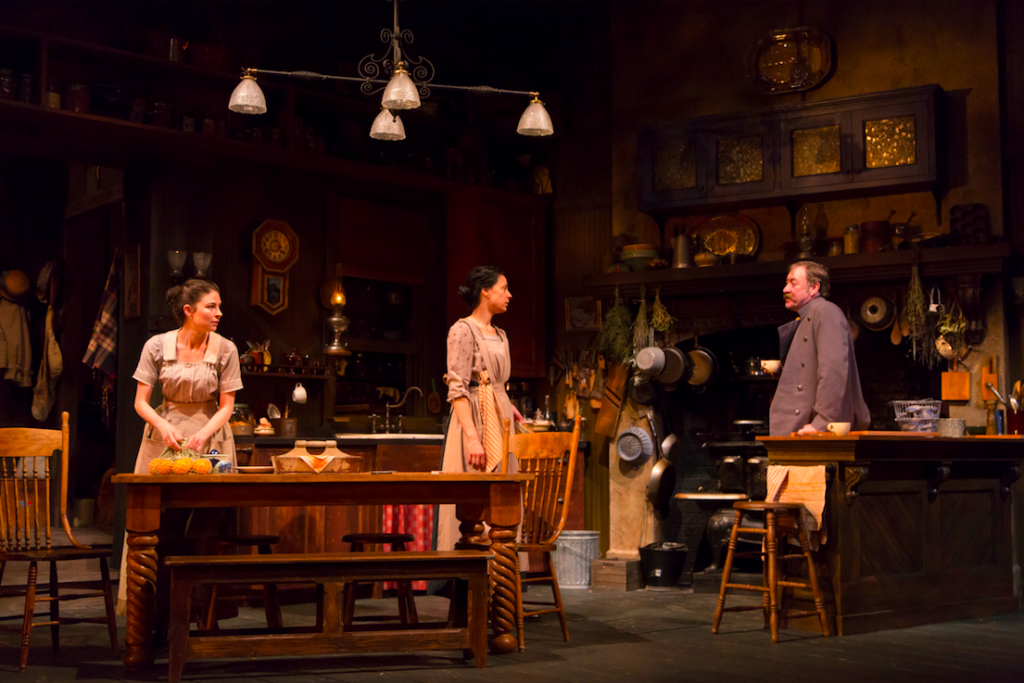By Stephanie Eisemann, news staff
“The Second Girl,” a new drama running at the Huntington Theatre until Feb. 21, explores what it’s like to leave everything behind for a better world.
When Cathleen O’Leary manages to survive the Titanic’s infamous wreck, she arrives in America to reunite with her aunt where they both must try to navigate what “better” really means. Throughout the show, Cathleen struggles with the plight of being an immigrant in America, family drama and her burgeoning relationship with Jack Smythe.
“The Second Girl” stars Christopher Donahue as Smythe, Kathleen McElfresh as Bridget O’Sullivan, the aunt, and MacKenzie Meehan as O’Leary.
Upon arrival, it’s difficult for the audience to absorb the incredibly intricate and detailed set while searching for their seats. But by the time the smell of bacon and eggs waft in from the kitchen, the functionality of the house and the props within it capture the audience’s attention. Coupled with the gradient sky backdrop, natural lighting effects and subtle bird chirping, the set feels like it really could be a summer home in 1912.
While initially the choice not to use blackouts for certain time transitions was surprising, the quality of the lighting and the human feel it brought to the passage of time fit the show. There are no scenes nor endings for these Irish servants, but rather just time spent and lost. The technical design team is arguably the strongest portion of the production.
The story of “The Second Girl” itself is a personal commentary for Irish immigrant and playwright Ronan Noone, a playwriting fellow at the Huntington Theatre. Noone penned this show 20 years after arriving in America as “an emotional exploration of adapting to a new world,” according to the show’s playbill.
Classic theatre connoisseurs will appreciate the nod to Eugene O’Neill’s “Long Day’s Journey into Night” with the Tyrone family – written as the unseen masters of the three-person ensemble cast of servants.
“The Second Girl” portrays the feelings of discontent and uncertainty of immigrants going through menial jobs and lives day after day. The drama had a bit of Irish humor and flashes of a surprising backstory and a few twists, but the play was mostly flat.The characters had depth and the plot had the potential to be moving, but the two-hour performance felt mostly unresolved.
In part, this is a creative parallel among the characters themselves who never find contentment, but the comparison was unsatisfactory because the play lacked a definitive climax to build emotion in the first place.
The quality of performance was in no way diminished, though, and the actors conveyed the struggle and passion of the characters. Kathleen McElfresh, playing O’Sullivan, had an especially difficult role. O’Sullivan is the resentful aunt of O’Leary who has sent money to bring her niece to America after years of solitude.
McElfresh portrayed with depth the difficult balance between Bridget’s resoluteness and and her continual slip into alcoholism. As she grapples with her desires and what she feels is proper, her relationship with her male suitor Smythe both progresses and regresses.
Smythe’s character has come to terms with the unhappy events and poor decisions of his past and now just wants quiet and honest contentment.
Donahue, true to his character, was candid and caring but ultimately unmemorable as he let the world on stage belong to O’Sullivan and O’Leary.
Meehan as O’Leary was the bright spot of the production. Portraying the younger, fierier and newly immigrated niece, Meehan brought energy to the stage and set the pace of the show. She made her character’s arc the most intriguing as she went from playful and optimistic to hurt and lost, but remained determined. Comedic sense was one of her strengths. With McElfresh, the two created an impressive and tense familial dynamic.
While the characters were interesting and well-acted, the story itself was underwhelming and failed to come to an adequate and satisfying conclusion.
For those who are looking for a more dramatic and conclusive way to spend two hours, see a late night screening of “Into the Woods.”
Photo courtesy T. Charles Erickson









